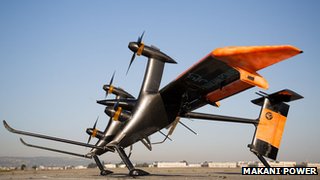
Google has acquired a US company that generates power using turbines mounted on tethered kites or wings.
Makani Power will become part of Google X – the secretive research and development arm of the search giant.
The deal comes as Makani carries out the first fully autonomous flights of robot kites bearing its power-generating propellers.
Google has not said how much it paid to acquire Makani, but it has invested $15m (£9.9m) in the company before now.
In a statement posted to its website, Makani said the deal would “provide Makani with the resources to accelerate our work to make wind energy cost competitive with fossil fuels”.
Rather than use fixed turbines to generate power, Makani has been experimenting with “flying wings” adorned with several smaller turbines that act as propellers as the craft takes off.
Makani claims that mounting the turbines on a wing is more efficient as large numbers can be built with fewer materials than traditional tower-based turbines. In addition, the robot wings can land to avoid damage if wind speeds are too high or during bad weather.
It plans to operate the tethered wings in small groups of six with each one anchored at the points of a hexagon. The wings operate between 250m (820ft)and 600m above ground.

